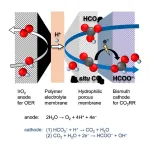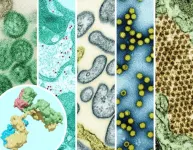Scientists reveal new design for cells turning carbon dioxide into a green fuel
New electrolyzer for reactive carbon capture boasts unrivalled selectivity
2024-09-14
(Press-News.org)
Tokyo, Japan – Researchers from Tokyo Metropolitan University have made strides forward in realizing industrial conversion of bicarbonate solution made from captured carbon to a formate solution, a green fuel. Their new electrochemical cell, with a porous membrane layer in between the electrodes, overcomes major issues suffered in reactive carbon capture (RCC) and achieves performances rivaling energy-hungry gas-fed methods. Processes like theirs directly add value to waste streams and are key to realizing net zero emissions.
Carbon capture technology is a big part of the global strategy to reduce emissions and fight climate change. But the important question of what we do with the captured carbon dioxide remains an open challenge. Do we simply push it underground, or is there more to it? Scientists certainly think so. Using state-of-the-art catalysts and chemical processes, work is under way to try and convert the captured product into something more useful for society.
One particularly enticing application is the conversion of carbon dioxide into an environmentally friendly fuel. Technology has been developed for using electrochemical cells to reduce the carbon dioxide to a formate compound, which itself can be used in formate fuel cells to generate power. However, a significant roadblock is the need for pure carbon dioxide: pressurizing carbon dioxide can be highly energy intensive. The gas is not converted very efficiently, and the cells do not last very long. Enter reactive carbon capture, where carbon dioxide dissolved in alkaline solutions, like bicarbonate solutions, can be directly used to create formate ions without the losses associated with providing pure gas. The key challenge facing researchers here is the design of a better electrochemical cell which can selectively produce formate ions from bicarbonate ions without losing out to side reactions, like the production of hydrogen.
Now, a team of researchers led by Professor Fumiaki Amano from Tokyo Metropolitan University have created a new cell with excellent selectivity for the conversion of bicarbonate ions into formate ions. In the new cell, electrodes made of catalytic material are separated from a polymer electrolyte membrane by a porous membrane made of cellulose ester. Hydrogen ions produced at one electrode pass through the electrolyte membrane and make it to the porous layer, where it reacts with bicarbonate ions to efficiently produce carbon dioxide in the pores. The gas is then converted to formate ions at the other electrode, also in contact with the porous membrane. When they put their cell to work, they found that the faradaic efficiency of their cell, the proportion of electrons converted to formate instead of other compounds, was 85%, even with very high currents. Not only does this outperform existing designs, the cell was found to operate smoothly for over 30 hours and realize nearly complete conversion of bicarbonate to formate. Once the water has been driven off, all that is left is solid, crystalline formate fuel.
Given the demands on climate change technology, improvements like this to the efficient running of electrochemical cells promises to have a big impact. The team hopes their new bicarbonate electrolyzer can be a viable option for society as it strives towards a green transformation.
This work was supported by Tokyo Metropolitan Government.
END
[Attachments] See images for this press release:

ELSE PRESS RELEASES FROM THIS DATE:
2024-09-14
Lakes can tip the scales from healthy to potential environmental hazard quickly when they become eutrophic. In this state, an abundance of nutrients accelerates algae growth, which then crowd the water’s surface and block light from reaching organisms below. Without light, they can’t make oxygen and life in the water begins to die off. Luckily, researchers can monitor inland lakes for eutrophication with remote sensing technologies; however, those technologies could be adjusted to make more accurate assessments, according to researchers based in China.
The team published their evaluation of the technologies, as well as recommended paths ...
2024-09-14
While planting trees may seem like an easy win to combat climate change, planted forests often encroach on natural forests, wetlands, and grasslands. This can reduce biodiversity, disturb the natural environment, and disrupt carbon and water cycling. While there has been a global increase in forest cover, it’s hard to know if this forest is the regeneration and growth of natural forests or if it is planting new trees. Accurately mapping these forests with remote sensing technology could help.
However, comprehensive maps of planted forests and natural forests are lacking even though it is possible to distinguish planted forests and natural forests on satellite images ...
2024-09-13
CHICAGO—September 13, 2024—The College of Architecture at Illinois Institute of Technology has been awarded the prestigious Zero Energy Design Designation (ZEDD) from the United States Department of Energy (DOE) for it Bachelor of Architecture and Master of Architecture programs. This recognition highlights the college’s commitment to sustainability, carbon neutrality, and zero-energy design practices in a world of escalating extreme weather and climate change.
The ...
2024-09-13
HOUSTON – (Sept. 13, 2024) – Generative artificial intelligence (AI) has notoriously struggled to create consistent images, often getting details like fingers and facial symmetry wrong. Moreover, these models can completely fail when prompted to generate images at different image sizes and resolutions.
Rice University computer scientists’ new method of generating images with pre-trained diffusion models ⎯ a class of generative AI models that “learn” by adding layer after layer of random noise to the images they are trained on and then generate new images by removing the added noise ⎯ could help correct ...
2024-09-13
The National Institutes of Health (NIH) has established a pandemic preparedness research network to conduct research on high-priority pathogens most likely to threaten human health with the goal of developing effective vaccines and monoclonal antibodies. Currently, many of the diseases caused by these pathogens have no available vaccines or therapeutics, and investing in this research is key to preparing for potential public health crises—both in the United States and around the world. NIH’s National Institute of Allergy and Infectious Diseases (NIAID) expects to commit approximately ...
2024-09-13
University of Virginia professor Mathews Jacob has secured a $3.9 million grant to advance his innovative research on detecting Alzheimer’s disease in its early stages. Jacob, who specializes in electrical and computer engineering, is teaming up with researchers from the University of Iowa and the University of California-San Francisco to push the boundaries of imaging technology that tracks the brain’s metabolic changes — offering a fresh perspective on studying neurodegenerative disorders.
Their focus is on advancing magnetic resonance spectroscopic imaging (MRSI). Unlike standard MRI, which primarily highlights structural changes, ...
2024-09-13
Flowers like hibiscus use an invisible blueprint established very early in petal formation that dictates the size of their bullseyes – a crucial pre-pattern that can significantly impact their ability to attract pollinating bees.
The study, by researchers at the University of Cambridge’s Sainsbury Laboratory also found that bees prefer larger bullseyes over smaller ones and fly 25% faster between artificial flower discs with larger bullseyes – potentially boosting efficiency for both bees and blossoms.
Patterns on the flowers of plants guide insects, like bees, to the centre of the flower, where nectar and pollen await, ...
2024-09-13
Men are three times more likely than women to commit traffic violations while driving and to be involved in accidents. Moreover, they are more likely to create situations on the road that are highly dangerous to others. Men are also twice as likely to drive under the influence and nearly one-third more likely to receive a prison sentence for reckless driving. Perhaps it comes down to cultural norms and the different attitudes men and women have toward driving. These are the conclusions reached by Anton Kazun, Assistant Professor at the HSE Faculty of Economic Sciences, and Research Assistant Mikhail Belov.
There is a stereotype that women are worse driver than men; female drivers are ...
2024-09-13
Researchers at University of California San Diego have published new guidelines that could help scientists significantly improve their results when quantifying the interactions between DNA and proteins. Understanding these interactions is critical to our understanding of human biology in general, and can also help scientists develop new treatments for a wide range of diseases, including many cancers.
The researchers focused on spike-in normalization, a widely-used molecular biology technique that helps ensure accurate and reliable results. Spike-in normalization involves adding a known quantity of chromatin (DNA and the associated proteins) to a sample before it ...
2024-09-13
As the global population grows and traditional livestock production increasingly strains environmental resources, there is a rising interest in alternative protein sources. Edible insects, particularly grasshoppers, are abundant in regions like Cameroon and provide essential nutrients, including proteins, amino acids, and minerals vital for health and growth. Addressing these challenges calls for in-depth studies on the nutritional benefits of insects such as Ruspolia nitidula.
Conducted by the University of Dschang, Cameroon, and published (DOI: 10.26599/FSAP.2024.9240068) in the journal Food Science of ...
LAST 30 PRESS RELEASES:
[Press-News.org] Scientists reveal new design for cells turning carbon dioxide into a green fuel
New electrolyzer for reactive carbon capture boasts unrivalled selectivity







